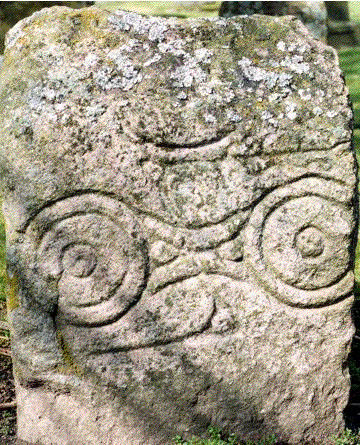in the Garioch (pron.gee-ree) excerpt from an Historical
information booklet produced in 1999 by the Inverurie Burgh Trades - available seasonally
from Tourism outlets and at all major business premises in the town - used with
permission.
THE ANCIENT REGALITY OF INVERURIE & THE GARIOCH
©1999 by Marian Youngblood
Strategically, Inverurie seems oddly situated in a flood-plain surrounded by rising hills
overshadowed by the classical mountain of Bennachie. Its origins tell a story
pre-Industrial age, pre-Reformation, pre-medieval, prehistoric. When, 5000 years ago, the
Garioch's first farmers chose to settle, grow food, protect their families from bear, boar
and wolves, build sacred stone circles to measure and celebrate the seasons, they were not
thinking of strategy, but a sacred sense of place. What became the royal burgh of
Inverurie, literally 'at the mouth or meeting of the Urie', was chosen because of its
massive water resource and rich land, but also because it was a safe crossing.
Fully 3,500 years later the indigenous Picts, descendants of those first farmers,
continuing a tradition of working stone, placed a carved symbol stone in the River Don at
the Stanners, its safest crossing point - its meaning clear to all: when the salmon symbol
could be seen on its face, the ford was passable; when the fish was not visible, the water
was too deep.
The prehistory of the Garioch has been treated as mysterious, laced with folklore,
denounced at the Reformation, and linked to superstition, ignorance and evil. At the end
of the second millennium of the Christian era, what emerges after the dust has settled is
a history of a people closely tied to bountiful land, working with weather and seasons to
make it fruitful. Double disc
& Z-rod Pictish symbol stone ©MCNagahiro

Pictish symbol stone in Inverurie's 'Castle Yards' - site of the medieval castle of David,
Earl of Huntingdon & the Garioch ©MCNagahiro
Early settlements on Corsman and Dilly Hills and Maiden
Castle on the slopes of Bennachie, protected from wild beasts, gave way to a palisaded
settlement around the Bass, the medieval Castle Yards, site of the earliest church. Here
and at Brandsbutt, Pictish missionaries from the late AD7th
century preached and converted inhabitants, inscribing crosses or names of early saints in
ogham on carved stones. Later, when the 9th century Scots kingdom overran Pictland, more
elaborate cross-carved stones, like the Maiden Stone at
Pittodrie, were erected to declare the accepted religion. An early-Historic mound, the
Cunninghillock, traditionally the burial place of Northern Pictish king Aedth (d.AD878 at
the hands of King Grig, founder/architect of Aberdeen harbour, d.AD889), stands protected
in a private garden in the older part of the town. A portion of the original market cross
formerly in the Kintore Arms courtyard, is preserved at the Masonic Hall, whose medieval
chairs were said to have been made from oak beams of Earl David's 12th century castle on
the Bass.
From earliest times Scots kings and nobles resided at Inverurie, making royal progresses
through the Northern kingdom : Indulf died at Cullen (AD962) protecting his court from
marauding 'Danes'. The Norse never succeeded in invading central Aberdeenshire or the
Garioch, thus leaving us with a fine array of intact placenames from earlier Pictish and
Gaelic descent. Macbeth (d.AD1057), Malcolm III and Queen Margaret all made progresses (d.
AD1093); David, Earl of Huntingdon and the Garioch, held his 12th century castle on the
Bass under Bartolf constable of Enrowri.
Fortunately, responsible planning in the 1980s and 1990s has ensured protection of the
Garioch's monuments, encouraging an interest in its unique history. back to Inverurie images
List of historic and prehistoric places to visit:
Inverurie
Bass & Pictish horse and symbol stones, Castle Yards NJ
780 206
Brandsbutt (Stonefield) Pictish symbol stone with ogham NJ 759
224
Cunninghillock burial mound NJ 774 208
Druidsfield, Crichie ritual enclosure & Pictish symbol stone NJ 779 196
Inverurie Cross NJ 777 215
Kinkell St. Michael's medieval church NJ 785 190
Kintore symbol stone, Aboyne Formaston Cross Slab, Carnegie Museum, Market Square
The Garioch
Balquhain Recumbent Stone Circle & quartz outlier stone NJ735 240
Balquhain medieval keep NJ 632 237
Bourtie Kirk Pictish symbol stone, 14thC effigies NJ804 248
Candle Hill, Insch fallen stone circle NJ 599 299
Candle Hill, Oyne Recumbent Stone Circle NJ 659 267
Candle Hill, Old Rayne Neolithic Stone Circle NJ 680 280
Drimmies Pictish symbol stone NJ 742 235
Dunnydeer Iron Age vitrified hillfort & 13thC castle gable NJ 612 281
Easter Aquhorthies Recumbent Stone Circle NJ 732 207
Gowk Stane, Oyne remains of stone circle NJ 677 257
Insch St. Drostan's kirk & 12thC inscribed stone, High Street NJ 634 281
Kintore Kirk Pictish symbol stone NJ 793 162
Kirkton of Bourtie Recumbent Stone Circle NJ 800 248
Loanhead of Daviot Recumbent Stone Circle NJ 747 288
Logie House Garden 3 Pictish symbol stones NJ 703 258
Maiden Castle prehistoric settlement & causeway NJ 694 244
Maiden Stone 9thC Scots cross-slab with symbols NJ 703 247
Mither Tap o' Bennachie Iron Age 'hillfort' stone enclosure NJ 682 223
Picardy Stone, Pictish symbol stone, Myreton NJ 609 303
Stonehead Recumbent Stone Circle, Insch NJ 600 287
 is a non-profit charitable organization registered in Scotland with
the Capital Taxes Office number ED/455/89/JP is a non-profit charitable organization registered in Scotland with
the Capital Taxes Office number ED/455/89/JP
©1999-2000Friends of Grampian Stones
Marian Youngblood, Editor |
